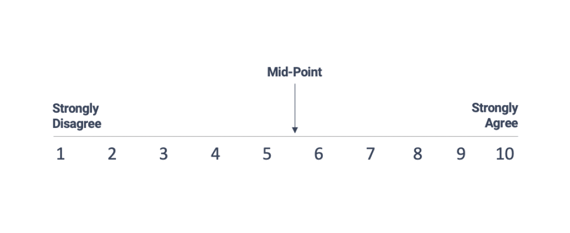How do I interpret the Joyous 0-10 rating scale?
The Joyous 0-10 rating scale is based on Bain & Company's NPS® scoring system.
Joyous rating scale questions use an 11-point scale with numbers ranging from 0-10. We classify scores of 0-6 as negative, 7-8 as neutral, and 9-10 as positive.
These are based on the same groupings as used in NPS research. Bain & Company (the creators of NPS) class Detractors as people who score a 0-6, Passives as people who score a 7-8, and Promoters as people who score a 9 or 10. They found these groupings and the zero to ten scale made intuitive sense for the people scoring for several reasons:
- Most people have experience with grades in school and correspond 9-10 with an A or A-, 7-8 with a B or C and below 6 as a failing grade
- Most of the world uses the metric system for commerce and trade because the decimal system works best for us as 10-digited humans
- Scales of 0 to 10 are used in sports and people typically know what is meant by 'A perfect 10'
- Doctors around the world use 0-10 scales to ask patients to rate their pain

Here's a few other reasons we use a 0-10 scale:
1) Data diversity & variability.
11-point scales produce higher levels of variance than five point scales. That's because 11-point scales offer more options for respondents to select from compared to 3, 5, or 7-point scales. More response options enables people to choose an option that aligns with their attitude. Fewer response options force people to categorise their attitude with a selection option that may not align with their views.
2) Odd number.
An odd number of selection options (e.g. 0-10) allows people to choose the mid-point.
-1.png?width=570&name=Frame%204%20(1)-1.png)
An even number (e.g. 1-10) forces people to choose above or below the mid-point.

3) Inclusion of 0.
One of the common confusions that people have with rating scales is knowing which end is positive and which is negative. And, this is partly because people don't always take the time to read the legends (e.g. Strongly Agree, Strongly Disagree).
With 1-5, 1-7, or 1-10 scales, responders can assume that the 1 represents something positive, when in fact, it may be negative. Starting a scale from 0 eliminates this confusion because zero is intuitively thought to represent something undesirable.
The interpretation of scales is subjective and will mean different things to different groups of people. This is why we recommend treating the scores as clues as to where change is needed the most. The comments and conversations are what you should be paying the most attention to. These will provide leaders with context that the numbers simply cannot.
References
- Dawes, J. (2002). Five point vs. eleven point scales: Does it make a difference to data characteristics. Australasian Journal of Market Research, 10(1), 39-47.
- Reichheld, F. (2011). The ultimate question 2.0 (revised and expanded edition): How net promoter companies thrive in a customer-driven world. Boston, Massachusetts: **Harvard Business Review Press.
- https://waypointgroup.org/why-a-0-10-scale-is-your-best-option/
- https://www.primary-intel.com/blog/the-magic-in-a-0-to-10-rating-scale/
- Scherpenzeel, A. (2002). Why use 11-point scales?. Swiss Household Panel (SHP), 9, 1-5.
Net Promoter®, NPS®, NPS Prism®, and the NPS-related emoticons are registered trademarks of Bain & Company, Inc., NICE Systems, Inc., and Fred Reichheld. Net Promoter ScoreSM and Net Promoter SystemSM are service marks of Bain & Company, Inc., NICE Systems, Inc., and Fred Reichheld.